The images below show my last planned shoot for this project, taken at the newly opened La Collette Recycling centre. These images are a follow-up to my last shoot depicting where Jersey’s household waste is taken and what happens to our un-separated rubbish. The new La Collette recycling centre opened on Monday the 16th of January this year and replaces the old household recycling centre at that was located at Bellozanne. Here you can bring household waste and recycling as well as donate anything and everything that could be reused by someone else. Below I have added the long list of the types of waste that can be recycled instead of burned at the La Collette facility…
After completing my previous research and shoots looking at the different varieties of waste pollution, where it’s found, and where it ends up. My last shoot for this project, presented below, portrays the options we have on our island and how easy it is to make a small difference in our lives and use it. Although I was planning on simply taking a documentary look at Jersey’s new and improved facility there were also a lot of beautiful and abstract features which I couldn’t help but present below. When completing this shoot I had to come back on two different occasions due to the workers there being instructed not to allow any unauthorised publicity or photographs. On my second visit, I was instructed of some safety features, giving a high visibility vest and asked to sign in and out in order to be allowed to continue. Apart from this slight set back all I needed to complete this shoot was my camera the location, as it is usually found, and natural light from the sun. The location is key in this shoot as my goal for these images is to simply spread awareness about this new facility and hopefully encourage my viewers to use it. Below are some of my original unedited photographs displayed in a contact sheet… To chose between these photographs and produce my final outcomes, I was particularly interested in having a mixture of dynamic straight photography as well as abstract photography to intrigue my viewers. When editing the landscape documentary photographs I experimented with the highlighting to really emphasise the dramatic sky. With the more abstract pieces, however, I concentrated on really bringing out the vibrant colours and brilliant texture. Unlike with most of my previous shoots, I have decided to keep all of my finals in colour. This is because, unlike my previous shoots, these images attempt to show something good and hopeful towards the environment. Below are my final chosen and edited 6 outcomes for this last shoot in my environmental project…
To chose between these photographs and produce my final outcomes, I was particularly interested in having a mixture of dynamic straight photography as well as abstract photography to intrigue my viewers. When editing the landscape documentary photographs I experimented with the highlighting to really emphasise the dramatic sky. With the more abstract pieces, however, I concentrated on really bringing out the vibrant colours and brilliant texture. Unlike with most of my previous shoots, I have decided to keep all of my finals in colour. This is because, unlike my previous shoots, these images attempt to show something good and hopeful towards the environment. Below are my final chosen and edited 6 outcomes for this last shoot in my environmental project…
 This first piece above was created by stitching three separate photographs together to make one easy to read piece. I have put them together because the ‘reduce, reuse, recycle’ sign featured at the Recycling centre is situated all in one long, hard to capture horizontal line. I love the effect of this sign that has been created using recycled items and kids toys to create a textured, colourful and inspiring outcome. The meaning behind this photograph is obvious as I am simply getting across this clear message from a straight forward perspective. The final result of this, I believe, emphasises the written message and brings out the beautiful and striking details.
This first piece above was created by stitching three separate photographs together to make one easy to read piece. I have put them together because the ‘reduce, reuse, recycle’ sign featured at the Recycling centre is situated all in one long, hard to capture horizontal line. I love the effect of this sign that has been created using recycled items and kids toys to create a textured, colourful and inspiring outcome. The meaning behind this photograph is obvious as I am simply getting across this clear message from a straight forward perspective. The final result of this, I believe, emphasises the written message and brings out the beautiful and striking details.
 These next two outcomes are my more abstracted results featuring some beautiful and inspiring artwork I captured when visiting the location. The meaning behind these two photographs is to intrigue the viewer about the recycling centre itself as well as spread the message of its importance. The first outcome on the left depicts a beautifully crafted recycling symbol made from a vast amount of green and red discarded children’s toys. I love the depth and contrast between the tiny objects as well as the vibrancy and texture of the whole piece. Next is a more abstract piece featuring the side and rooftop of the decorated facility building along with part of a growing tree. I love the strange symbolism in this piece and I like how, without context, the audience is forced to come to their own conclusions.
These next two outcomes are my more abstracted results featuring some beautiful and inspiring artwork I captured when visiting the location. The meaning behind these two photographs is to intrigue the viewer about the recycling centre itself as well as spread the message of its importance. The first outcome on the left depicts a beautifully crafted recycling symbol made from a vast amount of green and red discarded children’s toys. I love the depth and contrast between the tiny objects as well as the vibrancy and texture of the whole piece. Next is a more abstract piece featuring the side and rooftop of the decorated facility building along with part of a growing tree. I love the strange symbolism in this piece and I like how, without context, the audience is forced to come to their own conclusions.
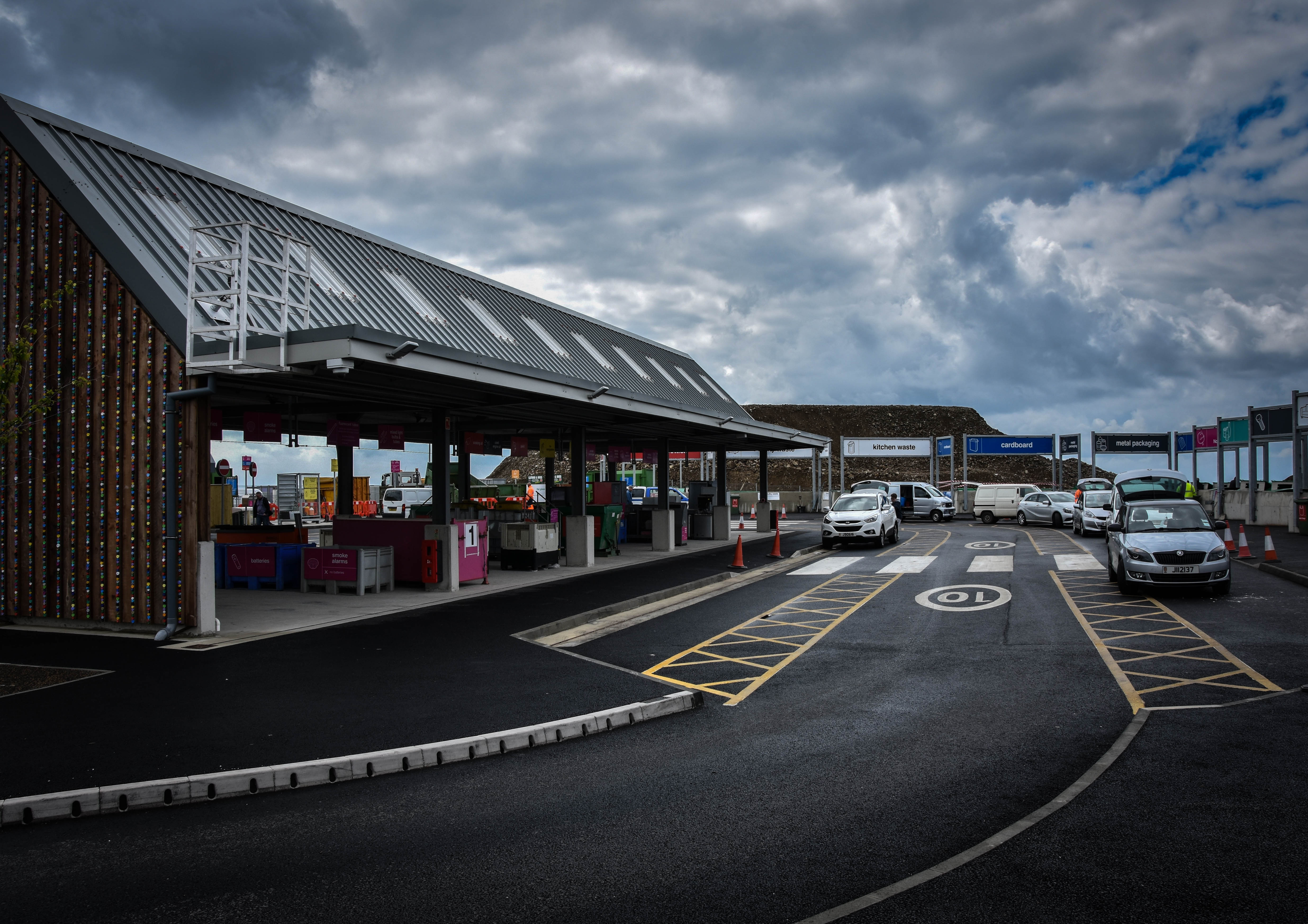 For this next documentary look at Jersey’s new and improved recycling facility, I have attempted to capture the location featuring as many important aspects as possible. My outcome above portrays the main recycling building on the left, the elegant car system running around the facility and a few of the many many drop-off points for waste that continues all the way around. The meaning behind this image is to show how the recycling centre now works and how effortless it is to drive around and dispose of our pollution safely. I have chosen this image as a final as I love the angled perspective of the facility and the dramatic overtones created with the contrast of the sky.
For this next documentary look at Jersey’s new and improved recycling facility, I have attempted to capture the location featuring as many important aspects as possible. My outcome above portrays the main recycling building on the left, the elegant car system running around the facility and a few of the many many drop-off points for waste that continues all the way around. The meaning behind this image is to show how the recycling centre now works and how effortless it is to drive around and dispose of our pollution safely. I have chosen this image as a final as I love the angled perspective of the facility and the dramatic overtones created with the contrast of the sky.
Lastly are two more of my documentary outcomes depicting the main features of the new recycling centre; the variety of different drop-off points. The meaning behind these photographs is simple as, like with the outcome above, I am trying to show the extent as to which they have improved Jersey’s recycling facility and made it as easy as possible for the public to use. The first image on the left depicts the electricals, mixed glass, metals and bulky waste containers with two members of staff in high-visibility jackets who are happy to help. Next, the image on the right depicts the same signs and more along with a member of the public discarding something into the bulky waste container. I like the perspective of the drop-off points in this picture and the contrast of the facility against the dramatic yet natural sky. 

 Because of my original plan to take as many photographs as possible of every aspect I was shown, the contact sheet above only shows 47 out of the 500+ images I took during my visit. To narrow down my outcomes from this selection above was quite difficult as I really liked many of the angles and compositions that I managed to capture. Below are the 14 images I have chosen as my final outcomes, although I won’t be using every image in my end result, I wanted to include them in this post for future reference to my efforts. As well as this, as requested by the manager of the energy from waste facility, Ian Williams, I have edited and saved about 16 more images to send to the department for unknown reasons. This shoot, much like my previous documentary shoots, shows a mixture of colour and black and white photographs depending on their style. Below I have displayed my final 14 outcomes along with four other images presented at the bottom that helps me to tell this documentary narrative…
Because of my original plan to take as many photographs as possible of every aspect I was shown, the contact sheet above only shows 47 out of the 500+ images I took during my visit. To narrow down my outcomes from this selection above was quite difficult as I really liked many of the angles and compositions that I managed to capture. Below are the 14 images I have chosen as my final outcomes, although I won’t be using every image in my end result, I wanted to include them in this post for future reference to my efforts. As well as this, as requested by the manager of the energy from waste facility, Ian Williams, I have edited and saved about 16 more images to send to the department for unknown reasons. This shoot, much like my previous documentary shoots, shows a mixture of colour and black and white photographs depending on their style. Below I have displayed my final 14 outcomes along with four other images presented at the bottom that helps me to tell this documentary narrative… This first group of my final outcomes above depicts the waste before transformation, the burning of the waste, and the ashy result of the process. The first two images on the top row depict the difference between the amount of household and commercial waste produced on our Island. The image on the left presents an average sized machine transporting commercial rubbish from one spot to another whereas the image on the right shows a gigantic claw machine, capable of moving up to 3 tonnes of household waste. For use in my project, I love the photograph on the right because of it dramatic intensity as well as its ability to give my viewers an idea of how much we produce. This image is one of my favourites overall and was taken through one of the ‘rubbish shoots’ after the operator kindly positioned the claw for me. The two pieces on the bottom row can show what could be seen of the burning process alongside with the final outcome of this waste. I love the orange glow and intriguing composition/aperture of the image on the right whereas the one on the left shows an important part of what happens to Jersey’s un-recycled waste. – this ash is actually re-purposed to be used in Jersey and England to create buildings and roads.
This first group of my final outcomes above depicts the waste before transformation, the burning of the waste, and the ashy result of the process. The first two images on the top row depict the difference between the amount of household and commercial waste produced on our Island. The image on the left presents an average sized machine transporting commercial rubbish from one spot to another whereas the image on the right shows a gigantic claw machine, capable of moving up to 3 tonnes of household waste. For use in my project, I love the photograph on the right because of it dramatic intensity as well as its ability to give my viewers an idea of how much we produce. This image is one of my favourites overall and was taken through one of the ‘rubbish shoots’ after the operator kindly positioned the claw for me. The two pieces on the bottom row can show what could be seen of the burning process alongside with the final outcome of this waste. I love the orange glow and intriguing composition/aperture of the image on the right whereas the one on the left shows an important part of what happens to Jersey’s un-recycled waste. – this ash is actually re-purposed to be used in Jersey and England to create buildings and roads.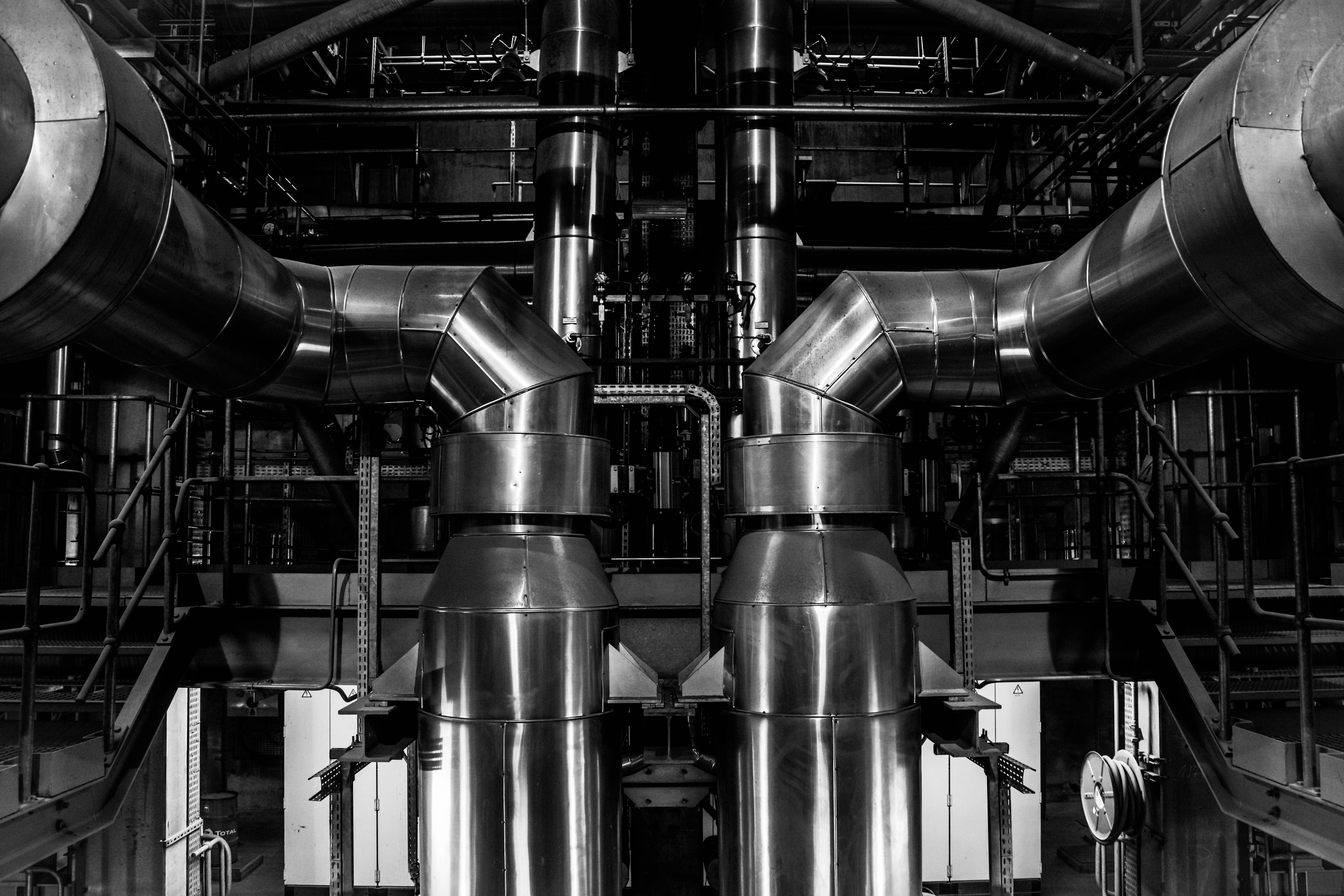 This next image is one of my favourite topographic style outcomes which was taken from inside the ‘Energy from Waste’ facility during my tour. This image depicts two massive pipes coming up from a lower floor and curling around the edge of my composition. I love the perfect symmetry I have captured in this piece and the topographic/straightforward style it was taken in. The reason I have decided to edit this image in black and white is to emphasise it dynamic features as well as resemble the many blast furnaces captured by my inspirations Bernhard and Hilla Becher. The meaning behind this image is to show a specific section of the massive machinery that combined, works to process the safe disposal of our island’s waste and turn it to clean energy.
This next image is one of my favourite topographic style outcomes which was taken from inside the ‘Energy from Waste’ facility during my tour. This image depicts two massive pipes coming up from a lower floor and curling around the edge of my composition. I love the perfect symmetry I have captured in this piece and the topographic/straightforward style it was taken in. The reason I have decided to edit this image in black and white is to emphasise it dynamic features as well as resemble the many blast furnaces captured by my inspirations Bernhard and Hilla Becher. The meaning behind this image is to show a specific section of the massive machinery that combined, works to process the safe disposal of our island’s waste and turn it to clean energy.
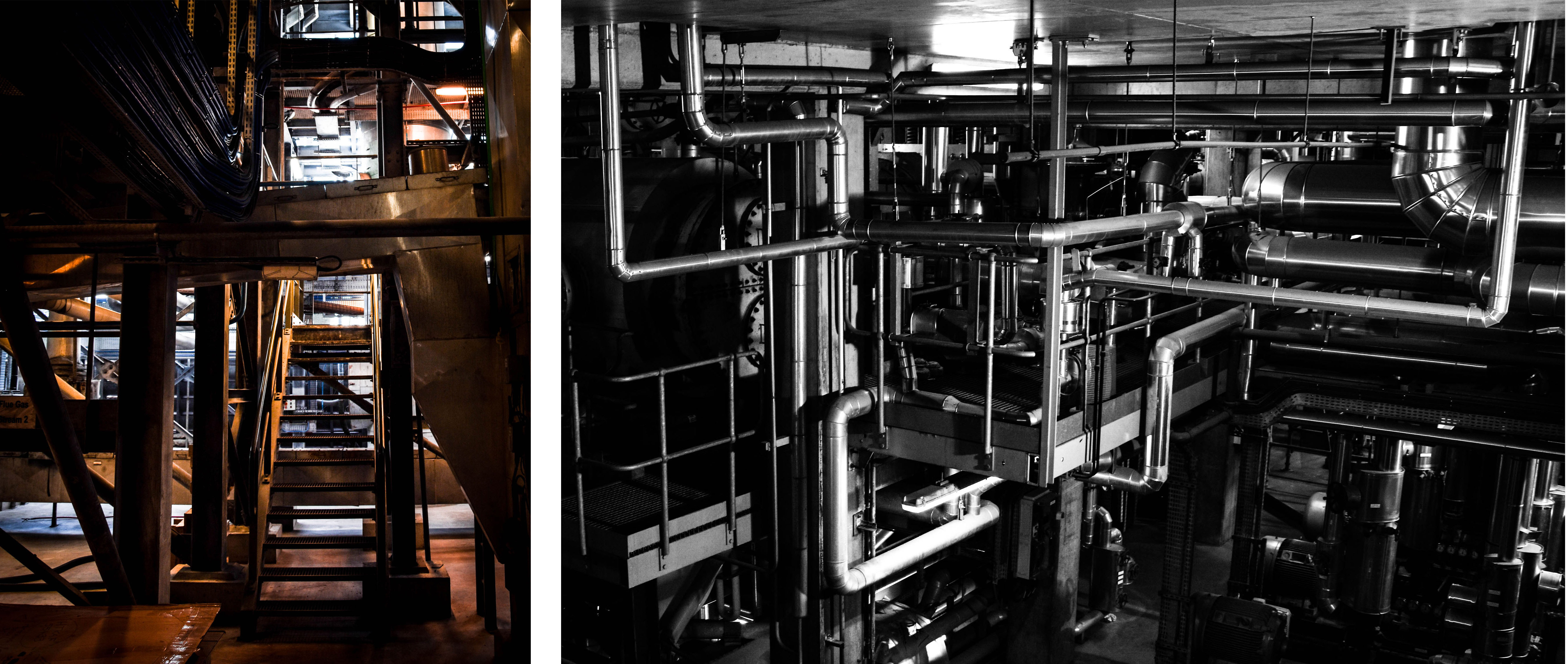 These next group of final outcomes from my shoot show more specific details from inside the ‘Energy from Waste’ facility. The meaning behind these images, along with the final outcome above, is to show exactly how much work and complicated technology goes into this process. These images can give an idea of just how difficult it is to cleanly produce only 7% of our island’s energy at the same time as disposing of our waste. The first and largest image on the top left is my favourite from this and depicts a scene through the building completely filled with pipes and machinery. I love the high contrast and dramatic overtones of this image and I think the intricacy of the pipe work really helps prove my point. The next two images on the right of this piece depict a few close-up detailed shots of specific parts of this extensive setup. I love the simplicity of these images as I feel they share a very strong topographic style. Lastly, the two photographs on the bottom row depict some amazing shadows and angels looking through the facility as well as more intricate pipe work hanging down from the ceiling.
These next group of final outcomes from my shoot show more specific details from inside the ‘Energy from Waste’ facility. The meaning behind these images, along with the final outcome above, is to show exactly how much work and complicated technology goes into this process. These images can give an idea of just how difficult it is to cleanly produce only 7% of our island’s energy at the same time as disposing of our waste. The first and largest image on the top left is my favourite from this and depicts a scene through the building completely filled with pipes and machinery. I love the high contrast and dramatic overtones of this image and I think the intricacy of the pipe work really helps prove my point. The next two images on the right of this piece depict a few close-up detailed shots of specific parts of this extensive setup. I love the simplicity of these images as I feel they share a very strong topographic style. Lastly, the two photographs on the bottom row depict some amazing shadows and angels looking through the facility as well as more intricate pipe work hanging down from the ceiling. Next are some important outcomes depicting a few of the elements that go into the purification of the smoke produced from burning the rubbish. According to CSBC, the La Colette ‘Energy to Waste’ facility meets the highest air quality standards in the whole of Europe. If their emission levels are outside of the licensed limits the plant is shut down and any underlying problem is rectified before the plant is started up again. The fist three images on the left depict some features that help keep track and purify the smoke before it is released. First is the point where samples are taken for testing, next on the top is a monitor for viewing the levels of each element and finally, the bottom image shows a very small part of the machine that acts as a filter. Lastly, on the right of this contact sheet is the view from outside the window looking up at the JEC chimney and the pipes that connect the two facilities.
Next are some important outcomes depicting a few of the elements that go into the purification of the smoke produced from burning the rubbish. According to CSBC, the La Colette ‘Energy to Waste’ facility meets the highest air quality standards in the whole of Europe. If their emission levels are outside of the licensed limits the plant is shut down and any underlying problem is rectified before the plant is started up again. The fist three images on the left depict some features that help keep track and purify the smoke before it is released. First is the point where samples are taken for testing, next on the top is a monitor for viewing the levels of each element and finally, the bottom image shows a very small part of the machine that acts as a filter. Lastly, on the right of this contact sheet is the view from outside the window looking up at the JEC chimney and the pipes that connect the two facilities.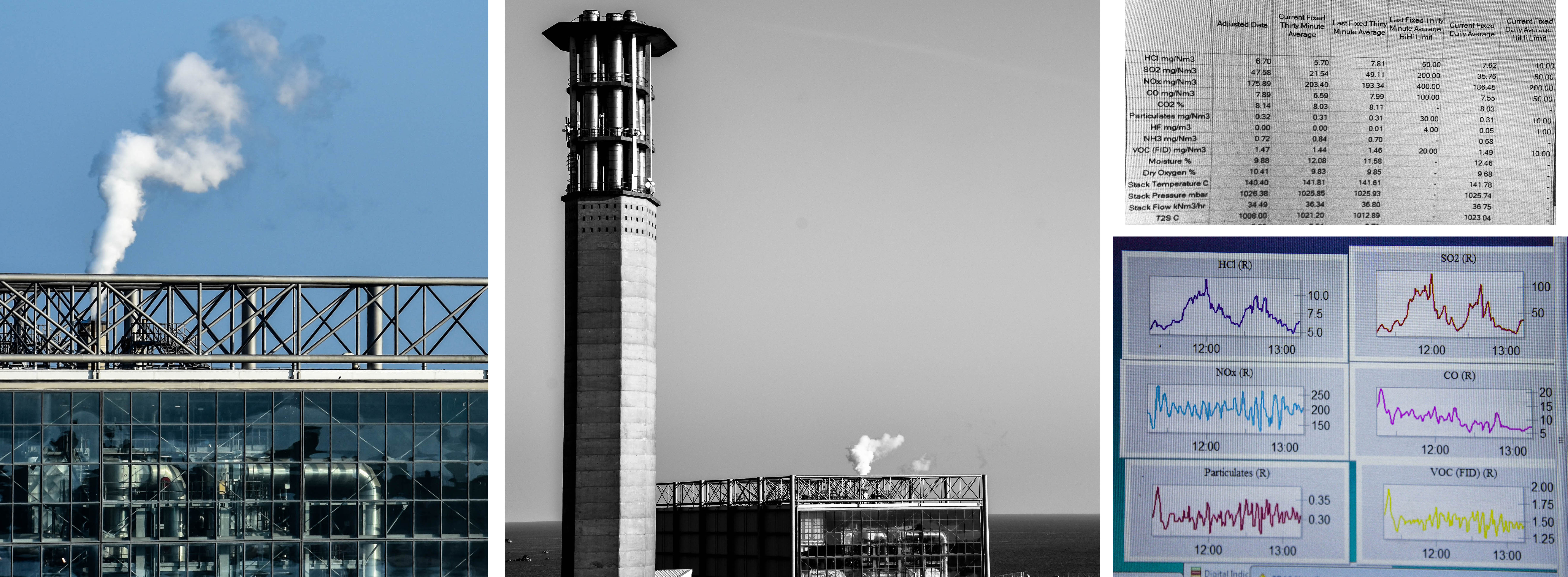
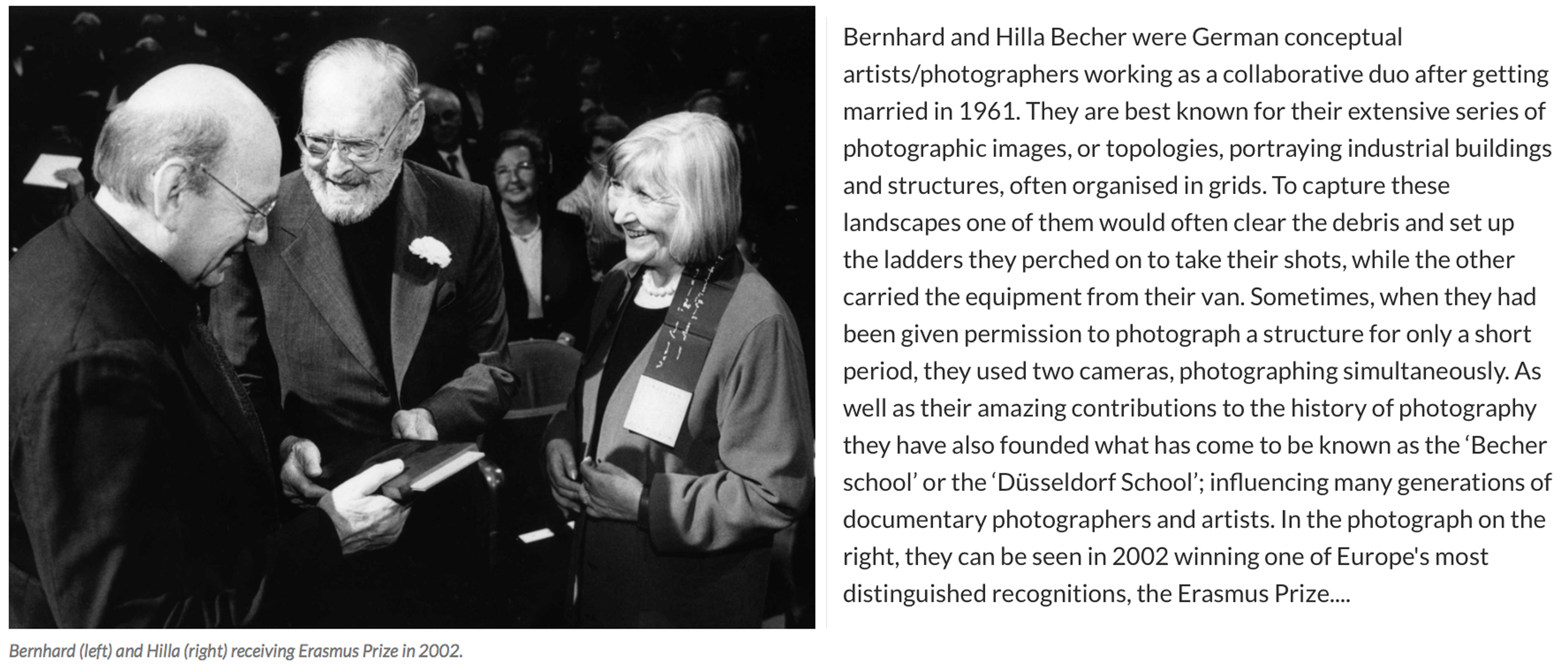 For over 40 years the pair used an 8×10 large-format camera to capture the architecture of industrialisation: water towers, coal bunkers, blast furnaces, gas tanks and factory facades. They did so in an obsessively formalist way that defined their own unique style and made them one of the most dominant influences in contemporary European photography and art. In the early years, with a young son in tow, they travelled across Europe and later the US for weeks at a time in a Volkswagen camper van, cooking and eating by the roadside. When asked in a recent interview why they only photographed industrial structures, Hilla replied: “Because they are honest. They are functional, and they reflect what they do – that is what we liked. A person always is what he or she wants to be, never what he or she is.” For Bernhard, the process of photographing and therefore fixing these brutalist structures forever was rooted in his love of the landscape he grew up in as a child. The huge buildings that dominated and defined his childhood in the Ruhr began to disappear rapidly in Germany’s postwar economic period, and he rightly sensed they would disappear elsewhere – across Europe, Britain and America. I have chosen this amazing couple as an inspiration for my next shoot at the ‘Energy from Waste’ facility because I absolutely love the simple yet fascinating way they have captured these artificial contraptions…
For over 40 years the pair used an 8×10 large-format camera to capture the architecture of industrialisation: water towers, coal bunkers, blast furnaces, gas tanks and factory facades. They did so in an obsessively formalist way that defined their own unique style and made them one of the most dominant influences in contemporary European photography and art. In the early years, with a young son in tow, they travelled across Europe and later the US for weeks at a time in a Volkswagen camper van, cooking and eating by the roadside. When asked in a recent interview why they only photographed industrial structures, Hilla replied: “Because they are honest. They are functional, and they reflect what they do – that is what we liked. A person always is what he or she wants to be, never what he or she is.” For Bernhard, the process of photographing and therefore fixing these brutalist structures forever was rooted in his love of the landscape he grew up in as a child. The huge buildings that dominated and defined his childhood in the Ruhr began to disappear rapidly in Germany’s postwar economic period, and he rightly sensed they would disappear elsewhere – across Europe, Britain and America. I have chosen this amazing couple as an inspiration for my next shoot at the ‘Energy from Waste’ facility because I absolutely love the simple yet fascinating way they have captured these artificial contraptions…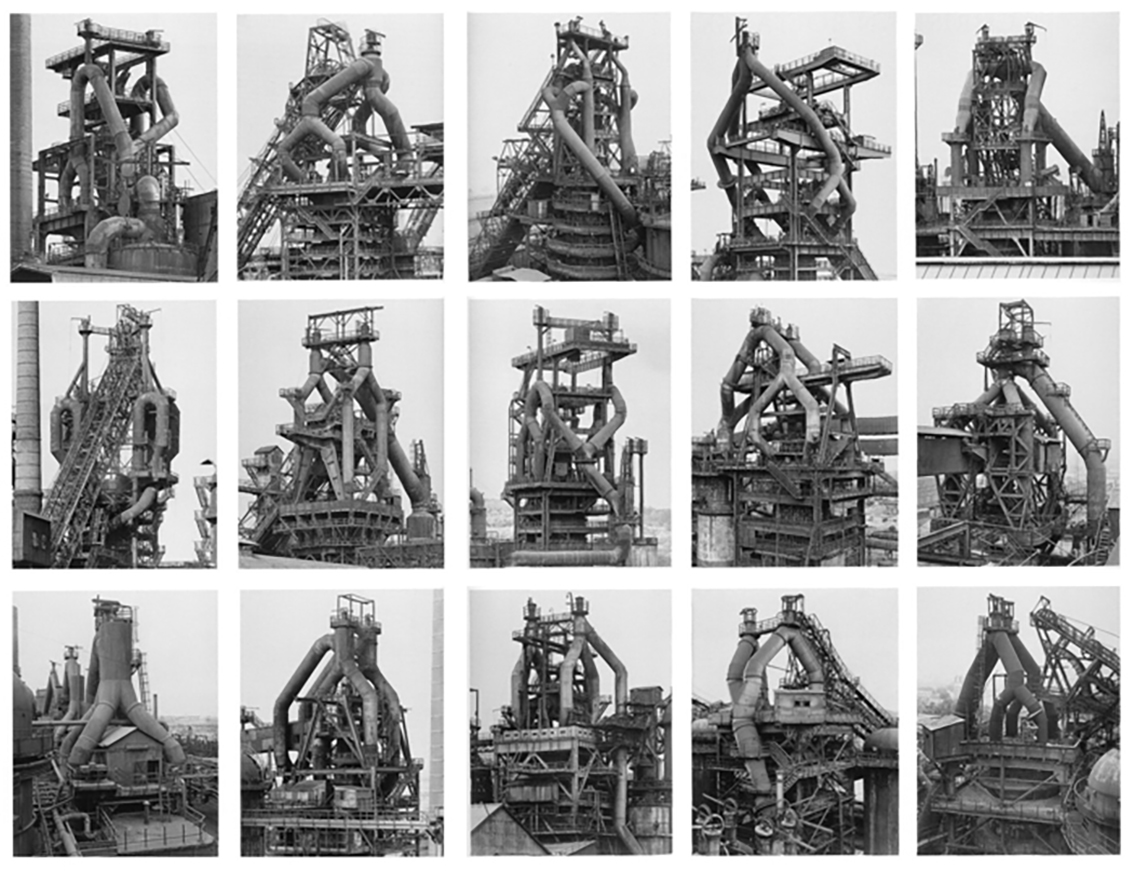 The Bechers were, first and foremost, formalists. “We want to offer the audience a point of view to understand and compare the different structures,” they once said. “Through photography, we try to arrange these shapes and render them comparable. To do so, the objects must be isolated from their context and freed from all association.” Much like the majority of the Becher’s work, this collection above depicts many different blast furnaces in different compositions, all printed in black and white and arranged in grids that emphasised their resemblance – what Hilla once called their “universality”. The meaning behind these images is to create straightforward historical documents of these vanishing industrial structures as well as beautiful topographic images. Although I will not be seeing this type of arrangement when visiting La Collette, I will be taking inspiration from the intricate way they have captured the angles and compositions from in between the pipes and framework.
The Bechers were, first and foremost, formalists. “We want to offer the audience a point of view to understand and compare the different structures,” they once said. “Through photography, we try to arrange these shapes and render them comparable. To do so, the objects must be isolated from their context and freed from all association.” Much like the majority of the Becher’s work, this collection above depicts many different blast furnaces in different compositions, all printed in black and white and arranged in grids that emphasised their resemblance – what Hilla once called their “universality”. The meaning behind these images is to create straightforward historical documents of these vanishing industrial structures as well as beautiful topographic images. Although I will not be seeing this type of arrangement when visiting La Collette, I will be taking inspiration from the intricate way they have captured the angles and compositions from in between the pipes and framework.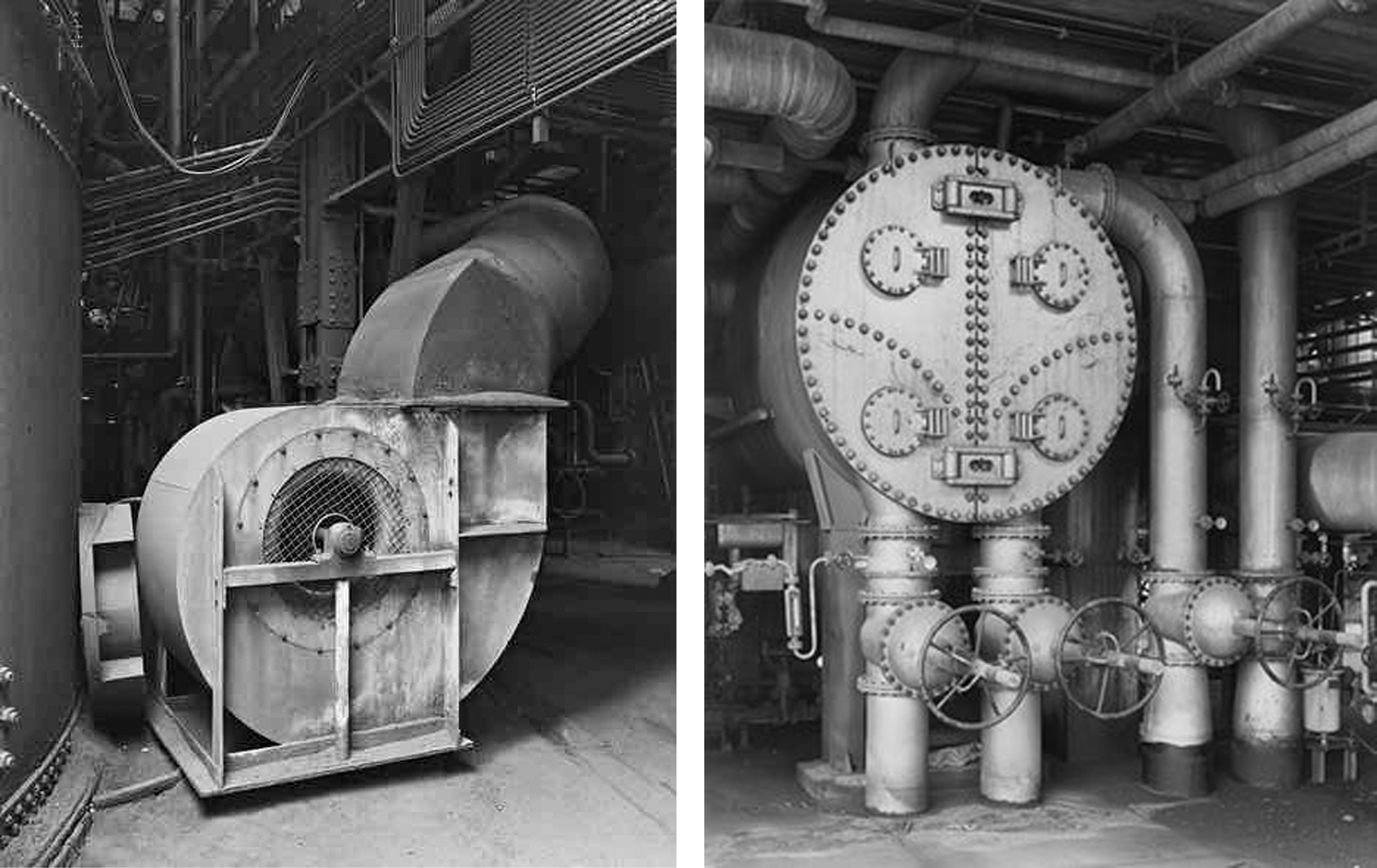
 As well as looking at the Bechers grid style outcomes I will also be taking a lot of inspiration from some of their more simple, close up work. The two photographs on the top row of the contact sheet above show detail captured from a Petrochemical Plant in 1983, Wesseling, Germany. These images depict some of the scenes I expect to find for my next shoot in the ‘Energy from Waste’ facility and I love their dynamic and structural composition. Below them, I have added three more industrial landscapes captured by the famous couple that was originally part of a much larger grid. These images depict old Stonework and Lime Kilns strategically captured against their environments. Alongside her late husband, Hilla saw structures that others might have dismissed as ugly, even threatening, and made them unforgettable.
As well as looking at the Bechers grid style outcomes I will also be taking a lot of inspiration from some of their more simple, close up work. The two photographs on the top row of the contact sheet above show detail captured from a Petrochemical Plant in 1983, Wesseling, Germany. These images depict some of the scenes I expect to find for my next shoot in the ‘Energy from Waste’ facility and I love their dynamic and structural composition. Below them, I have added three more industrial landscapes captured by the famous couple that was originally part of a much larger grid. These images depict old Stonework and Lime Kilns strategically captured against their environments. Alongside her late husband, Hilla saw structures that others might have dismissed as ugly, even threatening, and made them unforgettable. Since receiving the email above I have been in contact with the ‘Energy from Waste’ facility and have arranged to meet with them on Thursday the 20th of April at 10:45 am. My plan of action for this shoot is to record the site from an insider’s perspective using topography and documentary photography techniques. Whilst there I will be taking as many images as possible, attempting to capture some interesting compositions and angles to draw in my viewer’s attention. All I will need to complete this shoot is my camera and the safety equipment that will be provided upon arrival. My goal for this opportunity is to truthfully present what happens to Jersey’s un-recycled waste, as well as the elements that go into the transforming it into energy.
Since receiving the email above I have been in contact with the ‘Energy from Waste’ facility and have arranged to meet with them on Thursday the 20th of April at 10:45 am. My plan of action for this shoot is to record the site from an insider’s perspective using topography and documentary photography techniques. Whilst there I will be taking as many images as possible, attempting to capture some interesting compositions and angles to draw in my viewer’s attention. All I will need to complete this shoot is my camera and the safety equipment that will be provided upon arrival. My goal for this opportunity is to truthfully present what happens to Jersey’s un-recycled waste, as well as the elements that go into the transforming it into energy.

 When selecting my final outcomes out of the images above I wanted to make sure that I included a varied selection of each subject I have created. Below I have chosen five photographs (out of the 12 original images) that each show its subject matter either from a different viewpoint or in a different light. When it came to editing these photographs the first thing I did to all of them was make them more dramatic and eye-catching by playing with the exposure, shadows and contrast. After this, I judged each photograph individually and went through my normal editing routine of changing things like colour, temperature, clarity, saturation, highlights and blacks. The reason I have decided to keep all these outcomes in full colour is because they are aimed to catch my viewer’s attention and really stand out.
When selecting my final outcomes out of the images above I wanted to make sure that I included a varied selection of each subject I have created. Below I have chosen five photographs (out of the 12 original images) that each show its subject matter either from a different viewpoint or in a different light. When it came to editing these photographs the first thing I did to all of them was make them more dramatic and eye-catching by playing with the exposure, shadows and contrast. After this, I judged each photograph individually and went through my normal editing routine of changing things like colour, temperature, clarity, saturation, highlights and blacks. The reason I have decided to keep all these outcomes in full colour is because they are aimed to catch my viewer’s attention and really stand out. The final outcome above is my favourite result from this creative symbolism shoot. To create this subject matter I used a black sheet of fabric I had at home as well as a Nutella jar lid, some old fishing rope and loads of plastic bottle caps that I found on a few of Jersey’s beaches; ultimately arranging them into the shape of a fish. Although abstract and eye-catching the context of this image is to spread awareness about something very bleak. The reason I have created a fish is because it is a good symbol for the ocean and its ecosystem and can give the viewer an idea about the wider message I am trying to get across. I love how I have captured the composition of this subject matter and enhanced its dramatic intensity by manipulating colours, contrast and highlights.
The final outcome above is my favourite result from this creative symbolism shoot. To create this subject matter I used a black sheet of fabric I had at home as well as a Nutella jar lid, some old fishing rope and loads of plastic bottle caps that I found on a few of Jersey’s beaches; ultimately arranging them into the shape of a fish. Although abstract and eye-catching the context of this image is to spread awareness about something very bleak. The reason I have created a fish is because it is a good symbol for the ocean and its ecosystem and can give the viewer an idea about the wider message I am trying to get across. I love how I have captured the composition of this subject matter and enhanced its dramatic intensity by manipulating colours, contrast and highlights. The next final outcome displayed above depicts a jellyfish made with blue rope creating movement in the background, bottle caps forming the shape of its head, and separated strands rope as the tentacles. Although I was not really planning on creating this subject matter, as jellyfish are not really symbols of the whole underwater eco-system, I have found that this idea has, in fact, worked very well. The meaning of this subject is to show a futuristic world where all marine life has been replaced by our waste. This is futuristic tone is emphasised by the neon colours I have created and the black dark ocean background. Overall I think this abstract piece has a really strong centred composition and I have managed to create a really intriguing yet ominous tone.
The next final outcome displayed above depicts a jellyfish made with blue rope creating movement in the background, bottle caps forming the shape of its head, and separated strands rope as the tentacles. Although I was not really planning on creating this subject matter, as jellyfish are not really symbols of the whole underwater eco-system, I have found that this idea has, in fact, worked very well. The meaning of this subject is to show a futuristic world where all marine life has been replaced by our waste. This is futuristic tone is emphasised by the neon colours I have created and the black dark ocean background. Overall I think this abstract piece has a really strong centred composition and I have managed to create a really intriguing yet ominous tone.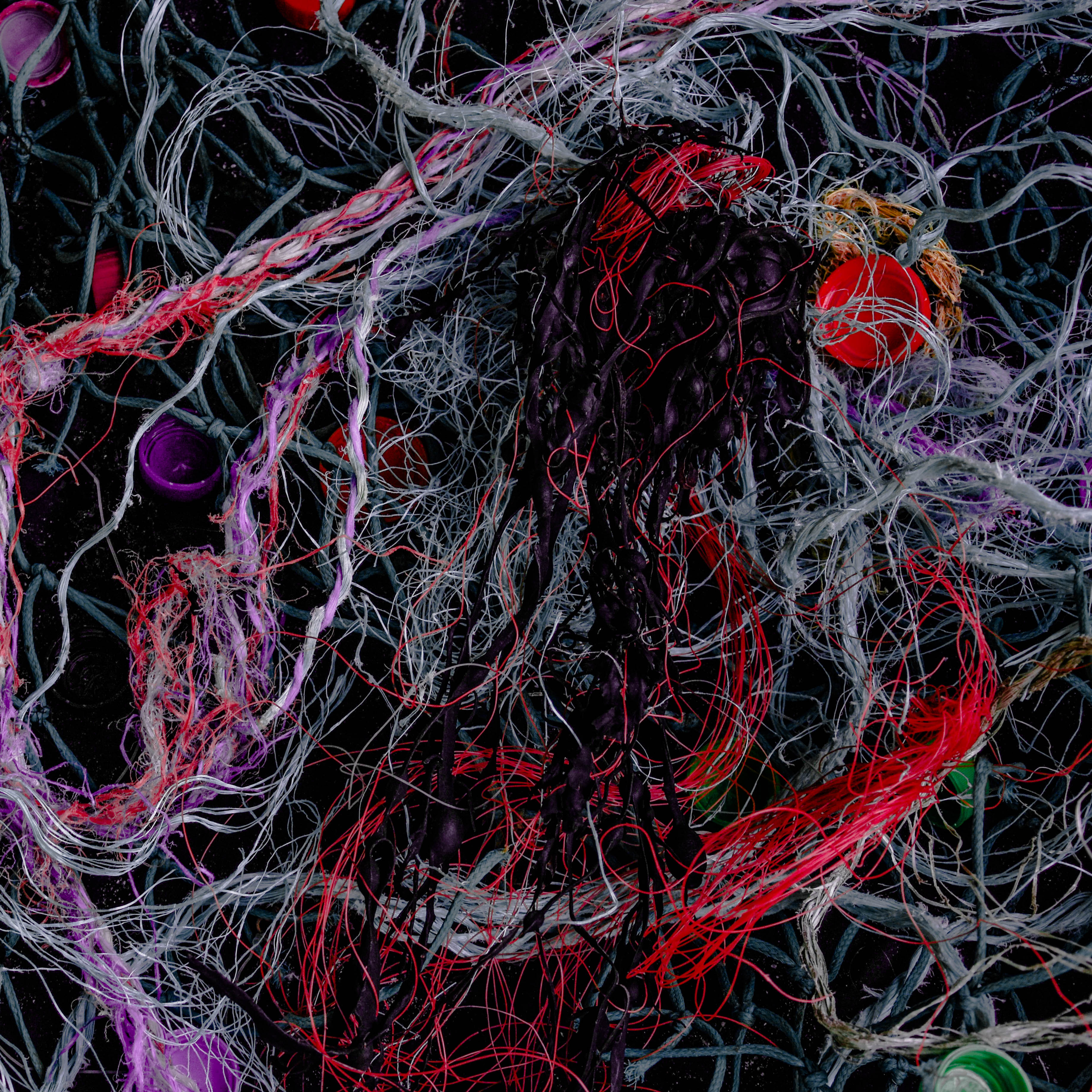 Next is an abstract image that has a very different subject matter to all my other final outcomes from shoot. This photograph depicts a massive amount of material and plastic fishing ropes/lines along with bottle caps and an oddly shaped piece of seaweed in the middle. The shocking thing about this, for me, is the how easily I managed to source these discarded materials washed up on a few of Jersey’s famous beaches. The symbolic message behind this image is pretty much a realistic version of the final above, where a jellyfish-shaped creature is being engulfed and tangled in pollution. The reason I chose this as final outcomes is because of the intriguing way I have managed to digitally manipulated the colours of certain ropes/lines and toned down all the rest.
Next is an abstract image that has a very different subject matter to all my other final outcomes from shoot. This photograph depicts a massive amount of material and plastic fishing ropes/lines along with bottle caps and an oddly shaped piece of seaweed in the middle. The shocking thing about this, for me, is the how easily I managed to source these discarded materials washed up on a few of Jersey’s famous beaches. The symbolic message behind this image is pretty much a realistic version of the final above, where a jellyfish-shaped creature is being engulfed and tangled in pollution. The reason I chose this as final outcomes is because of the intriguing way I have managed to digitally manipulated the colours of certain ropes/lines and toned down all the rest. Lastly are two more images that are aimed to give an insight into the problem of ocean pollution and hopefully make the viewer think twice about how they discard their waste. The meaning behind these two photographs is quite similar in that they both show a futuristic ocean scene that has been completely taken over by synthetic substances. The first piece on the left is simply a differently captured and edited version of the larger final outcome above. I have chosen to add this to my results blog post as well because I love the dramatic effect the subject has it fades into an ominous black border. The last image is of my fourth subject matter that I had previously planned out to depict a wave created by pollution. I love this outcome as I think the message is really clear as well as the composition of materials showing movement and intricate textures.
Lastly are two more images that are aimed to give an insight into the problem of ocean pollution and hopefully make the viewer think twice about how they discard their waste. The meaning behind these two photographs is quite similar in that they both show a futuristic ocean scene that has been completely taken over by synthetic substances. The first piece on the left is simply a differently captured and edited version of the larger final outcome above. I have chosen to add this to my results blog post as well because I love the dramatic effect the subject has it fades into an ominous black border. The last image is of my fourth subject matter that I had previously planned out to depict a wave created by pollution. I love this outcome as I think the message is really clear as well as the composition of materials showing movement and intricate textures.
 My plan of action for this next shoot is to use the designs I have drawn out above, a ‘home studio’ and interesting compositions to capture this pollution issue in a colourful, eye-catching and insightful way. To complete this shoot I will be using the materials I have already collected during my previous beach clean ups, black fabric as the background and a mixture of artificial and natural light. My goal is to produce emotive outcomes portraying marine life and ocean scenes by only using the pollution we cover it in. I have decided to use a fish as the subject for this shoot because, much like with the sculptures from ‘Washed Ashore’, I want to put across that it’s the sea life that is most affected by pollution. The fish is the most common creature found in the sea, hence why I will be using to symbolise my message about marine life. To create fine details and make the subject stand out more I will also be using salt as an ocean themed artistic material. For the waves design, I am aiming to show that this problem is very condensed and will eventually effect ‘every wave in the sea’. I love the examples I have managed to find and present for inspiration on how to create this kind of inspiring art. When the element of photography is added to capture the subject properly, I think this idea will produce some really nice emotive outcomes.
My plan of action for this next shoot is to use the designs I have drawn out above, a ‘home studio’ and interesting compositions to capture this pollution issue in a colourful, eye-catching and insightful way. To complete this shoot I will be using the materials I have already collected during my previous beach clean ups, black fabric as the background and a mixture of artificial and natural light. My goal is to produce emotive outcomes portraying marine life and ocean scenes by only using the pollution we cover it in. I have decided to use a fish as the subject for this shoot because, much like with the sculptures from ‘Washed Ashore’, I want to put across that it’s the sea life that is most affected by pollution. The fish is the most common creature found in the sea, hence why I will be using to symbolise my message about marine life. To create fine details and make the subject stand out more I will also be using salt as an ocean themed artistic material. For the waves design, I am aiming to show that this problem is very condensed and will eventually effect ‘every wave in the sea’. I love the examples I have managed to find and present for inspiration on how to create this kind of inspiring art. When the element of photography is added to capture the subject properly, I think this idea will produce some really nice emotive outcomes.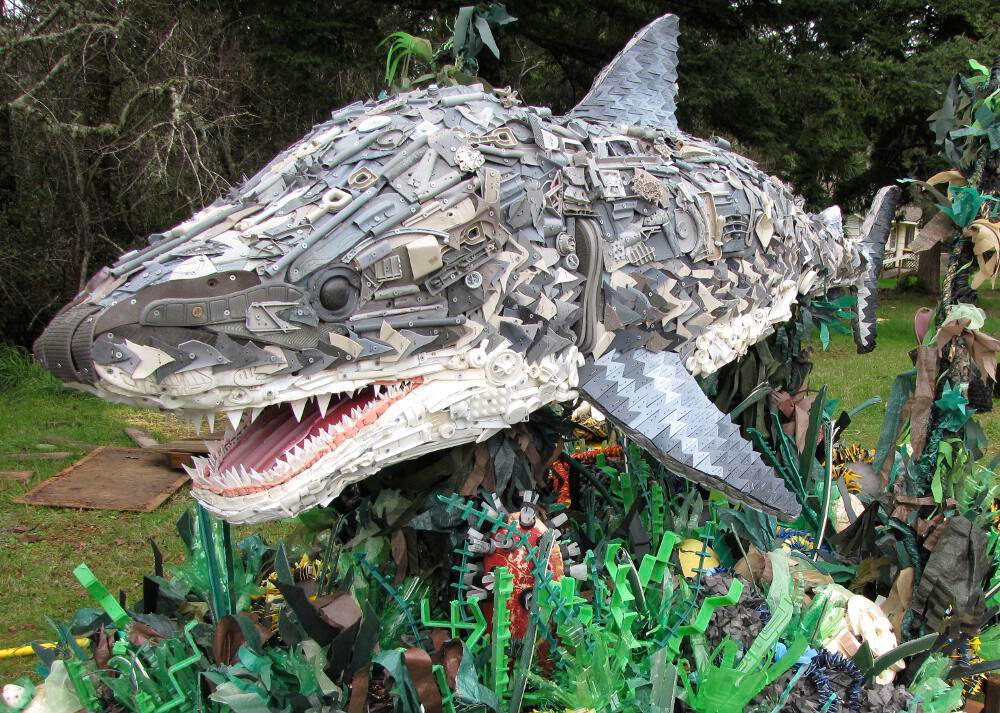 Above is a huge sculpture depicting what looks like a great white shark created using an array of different discarded materials. To put these masterpieces together the ‘Washed Ashore Project‘ volunteers collect rubbish that has been removed from beaches through community cleanups. This pollution is then washed, sorted and prepared for the creation process. Each sculpture is designed and directed by a professional artist and then formed through a collaboration of Washed Ashore team members, volunteers and students. The meaning behind these sculptures is to symbolically present our ocean pollution crisis and inspire change in our modern consumer culture. I love the use of small plastic items to collectively display such a textured and detailed masterpiece. The size of the shark and its surroundings, plus the sheer amount small and dangerous pieces of plastic collected from the beach, really make this piece something to think about.
Above is a huge sculpture depicting what looks like a great white shark created using an array of different discarded materials. To put these masterpieces together the ‘Washed Ashore Project‘ volunteers collect rubbish that has been removed from beaches through community cleanups. This pollution is then washed, sorted and prepared for the creation process. Each sculpture is designed and directed by a professional artist and then formed through a collaboration of Washed Ashore team members, volunteers and students. The meaning behind these sculptures is to symbolically present our ocean pollution crisis and inspire change in our modern consumer culture. I love the use of small plastic items to collectively display such a textured and detailed masterpiece. The size of the shark and its surroundings, plus the sheer amount small and dangerous pieces of plastic collected from the beach, really make this piece something to think about.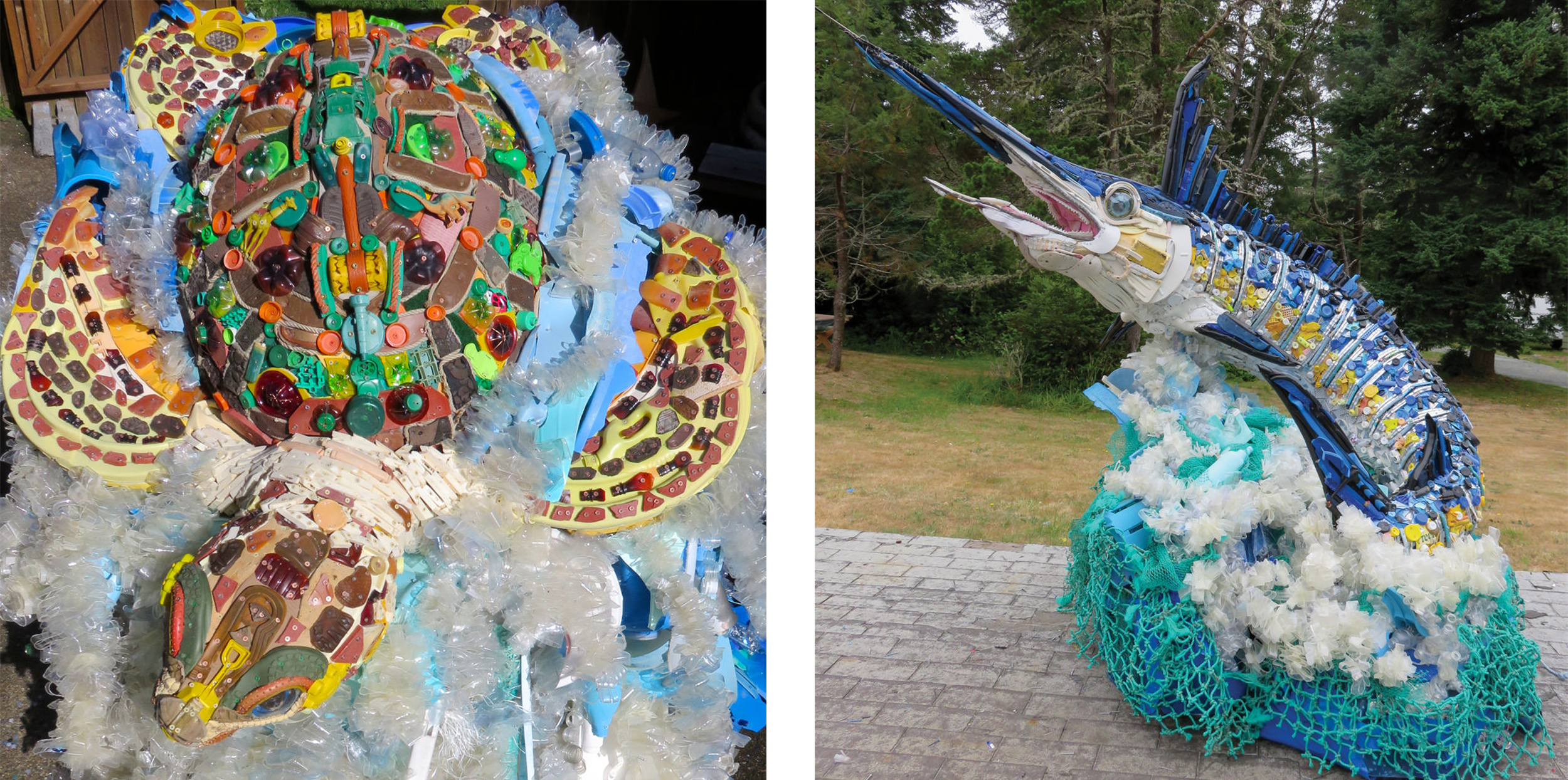 The next two photographs depict other transportable and inspiring pieces of art that portray a few creatures who are most affected by ocean pollution. The first sculpture on the right shows a carefully crafted sea turtle put together using discarded materials found on the beach such as water bottles, boots, shotgun shells, detergent bottles etc. The sculpture on the left depicts a Marlin fish created using things like sunglasses, toothbrushes, fishing lures and a toilet seat. I love the textured effect these creatures are given by being made up of such tiny pollution elements as well as the array of colours that can be presented. The size of these sculptures, along with their beautifully thought out structure, can definitely emphasise this pollution crisis and give the public a good idea of just how massive it is. All artists, volunteers and designers involved in the creation of these pieces will have been influenced by our current consumer culture. The sculptures’ construction is truly a community effort, with volunteers collecting, cleaning, sorting, and building the sculptures together.
The next two photographs depict other transportable and inspiring pieces of art that portray a few creatures who are most affected by ocean pollution. The first sculpture on the right shows a carefully crafted sea turtle put together using discarded materials found on the beach such as water bottles, boots, shotgun shells, detergent bottles etc. The sculpture on the left depicts a Marlin fish created using things like sunglasses, toothbrushes, fishing lures and a toilet seat. I love the textured effect these creatures are given by being made up of such tiny pollution elements as well as the array of colours that can be presented. The size of these sculptures, along with their beautifully thought out structure, can definitely emphasise this pollution crisis and give the public a good idea of just how massive it is. All artists, volunteers and designers involved in the creation of these pieces will have been influenced by our current consumer culture. The sculptures’ construction is truly a community effort, with volunteers collecting, cleaning, sorting, and building the sculptures together.
 This contact sheet above shows all of my favourite clear and interesting above water shots. As you can see I did manage to take a few photographs underwater although it would only work 1/10 times and the quality is very poor. When editing these images I cropped them down massively to only include the most important and interesting features. Below are my 8 documentary/abstract finals for looking at ocean pollution…
This contact sheet above shows all of my favourite clear and interesting above water shots. As you can see I did manage to take a few photographs underwater although it would only work 1/10 times and the quality is very poor. When editing these images I cropped them down massively to only include the most important and interesting features. Below are my 8 documentary/abstract finals for looking at ocean pollution… This first final is a documentary style photograph depicting the waste I found on Faldouet beach that would later be washed into the sea at high tide. To capture this image I carefully gathered the biggest examples of pollution together and let them float on the surface as an example of public pollution reaching the sea. I chose this as a final outcome for this shoot because of the images high-quality (for and iPhone), interesting subject composition and amazing natural colours. With this photograph, I hope to get across the message that this problem is real, effects all areas, and is rapidly getting worse. I like the calm sense you get from the flat and clear sea as it strongly contradicts the travesty of the plastic floating on top. Compared to other historical evidence of ocean pollution this image is very tame, however, because of is centred subject and beautiful scenery I think it can get across a very clear warning that we are destroying this ecosystem.
This first final is a documentary style photograph depicting the waste I found on Faldouet beach that would later be washed into the sea at high tide. To capture this image I carefully gathered the biggest examples of pollution together and let them float on the surface as an example of public pollution reaching the sea. I chose this as a final outcome for this shoot because of the images high-quality (for and iPhone), interesting subject composition and amazing natural colours. With this photograph, I hope to get across the message that this problem is real, effects all areas, and is rapidly getting worse. I like the calm sense you get from the flat and clear sea as it strongly contradicts the travesty of the plastic floating on top. Compared to other historical evidence of ocean pollution this image is very tame, however, because of is centred subject and beautiful scenery I think it can get across a very clear warning that we are destroying this ecosystem.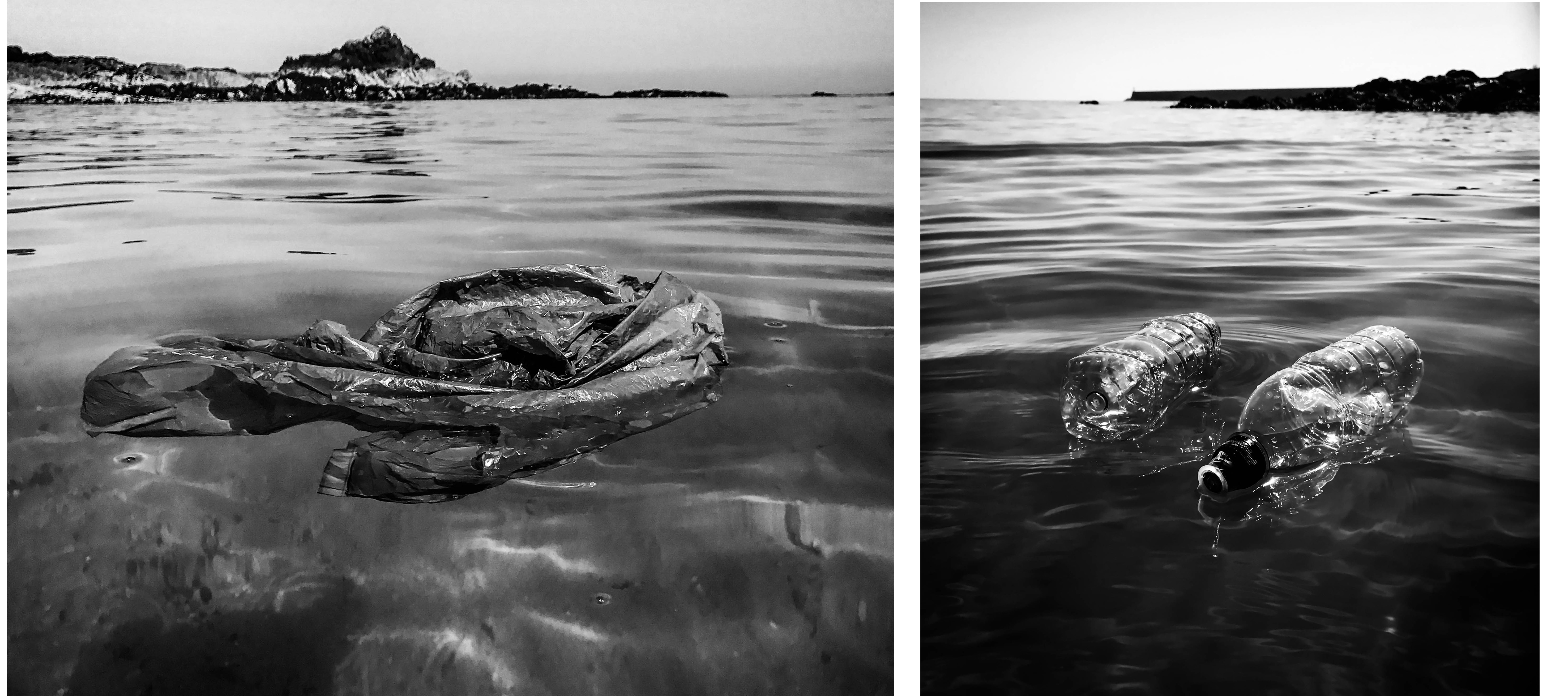 These next two finals are my other documentary style edits that I believe can clearly get across my message. By using straight photography techniques I have created a sense of this harsh reality and given my viewer a way to clearly analyse the subject matter and better understand this collection. The first image on the left depicts a plastic bag spread out and floating on top of/underneath the surface. I love the effect making this image black and white has, as it creates this sense of dread and makes the subject appear more ominous. I chose this image out of my 300 or so originals because of the way the bag is spread out at this one specific moment, making it unmistakable for anything else. The next photograph on the right shows to plastic bottles floating in front of a pier. I really like the symmetry and parallel composition of the subjects and the way they have reflected the natural light. Again I think this image is much more effective in black and white as it gives it a very dark and gloomy overtone, perfect for getting across the depressing meaning behind the photograph.
These next two finals are my other documentary style edits that I believe can clearly get across my message. By using straight photography techniques I have created a sense of this harsh reality and given my viewer a way to clearly analyse the subject matter and better understand this collection. The first image on the left depicts a plastic bag spread out and floating on top of/underneath the surface. I love the effect making this image black and white has, as it creates this sense of dread and makes the subject appear more ominous. I chose this image out of my 300 or so originals because of the way the bag is spread out at this one specific moment, making it unmistakable for anything else. The next photograph on the right shows to plastic bottles floating in front of a pier. I really like the symmetry and parallel composition of the subjects and the way they have reflected the natural light. Again I think this image is much more effective in black and white as it gives it a very dark and gloomy overtone, perfect for getting across the depressing meaning behind the photograph. For my first abstract final of ocean pollution presented above, I have captured a close-up image of a plastic bottle floating on top of the water. This final, as well as the ones below, are all inspired by the beautiful work of Steven Hirsch and his take on capturing the surface and pollution of water. I decided to take this image when noticing the inside of the bottle start to steam up and create an array of interesting colours. This effect, mixed with my adjustments made in post production is what has created this vibrant and intriguing piece. The meaning behind this image is to draw the viewer’s attention with its surreal beauty. I think this is an important technique to include in my pollution project as not everyone reacts well to straightforward portrayals of the truth. I also like the subtle definition of this piece as I believe it is possible to work out what the subject is from the indents of the rings around the bottle as well as the many emphasised water droplets on the side.
For my first abstract final of ocean pollution presented above, I have captured a close-up image of a plastic bottle floating on top of the water. This final, as well as the ones below, are all inspired by the beautiful work of Steven Hirsch and his take on capturing the surface and pollution of water. I decided to take this image when noticing the inside of the bottle start to steam up and create an array of interesting colours. This effect, mixed with my adjustments made in post production is what has created this vibrant and intriguing piece. The meaning behind this image is to draw the viewer’s attention with its surreal beauty. I think this is an important technique to include in my pollution project as not everyone reacts well to straightforward portrayals of the truth. I also like the subtle definition of this piece as I believe it is possible to work out what the subject is from the indents of the rings around the bottle as well as the many emphasised water droplets on the side. These three finals above are a mixture of colour and black and white abstract pieces intended to capture the viewer’s interest and make them think about the context themselves. The meaning behind the photographs is to show something that has devastating repercussions in a beautiful way, thus subtly informing the public of one of modern society’s biggest environmental problems. In this context the pictures may be considered as fine art photography, meaning that my message may be able to get across to people who would have no interest in conservation photography. The first colour final on the left is a low angle shot of a plastic bottle and its reflection on the ripples of the water’s surface. I like the confusing and abstract look of the bottle that was created by using a very shallow depth of field. The next outcome in the middle shows the bottom of the bottle, seemingly melting down onto the calm black ocean surface. Lastly, the photograph on the right is a cropped close-up of all three pollution subjects I used in the shoot. I like these items together and their proximity along with the water in between says a lot about this issue.
These three finals above are a mixture of colour and black and white abstract pieces intended to capture the viewer’s interest and make them think about the context themselves. The meaning behind the photographs is to show something that has devastating repercussions in a beautiful way, thus subtly informing the public of one of modern society’s biggest environmental problems. In this context the pictures may be considered as fine art photography, meaning that my message may be able to get across to people who would have no interest in conservation photography. The first colour final on the left is a low angle shot of a plastic bottle and its reflection on the ripples of the water’s surface. I like the confusing and abstract look of the bottle that was created by using a very shallow depth of field. The next outcome in the middle shows the bottom of the bottle, seemingly melting down onto the calm black ocean surface. Lastly, the photograph on the right is a cropped close-up of all three pollution subjects I used in the shoot. I like these items together and their proximity along with the water in between says a lot about this issue. My last final displayed above is an abstract piece that was heavily inspired by one of Steven Hirsch’s beautiful examples of water pollution. The smaller image on the right shows the piece from his project capturing the pollution in Brooklyn’s canal that I used as an inspiration when planning this shoot. My final is a recreation of this image created with a plastic bag placed just beneath the ocean’s surface. These types of photographs are also very much influenced by today’s modern consumer culture and the ever-growing problem of human waste. Like with Hirsch’s project and my previous abstracted outcomes, the meaning behind this image is to intrigue all types of viewers and subtly remind/inform them of this issue. I love the way I have captured the same kinds of ‘surface ripple’ effects as my inspiration but have done so in my own abstracted style. I also love how the natural light is intensified and distorted through the water’s surface, as well as the blue writing on the plastic bag creating a very interesting and twisted pattern.
My last final displayed above is an abstract piece that was heavily inspired by one of Steven Hirsch’s beautiful examples of water pollution. The smaller image on the right shows the piece from his project capturing the pollution in Brooklyn’s canal that I used as an inspiration when planning this shoot. My final is a recreation of this image created with a plastic bag placed just beneath the ocean’s surface. These types of photographs are also very much influenced by today’s modern consumer culture and the ever-growing problem of human waste. Like with Hirsch’s project and my previous abstracted outcomes, the meaning behind this image is to intrigue all types of viewers and subtly remind/inform them of this issue. I love the way I have captured the same kinds of ‘surface ripple’ effects as my inspiration but have done so in my own abstracted style. I also love how the natural light is intensified and distorted through the water’s surface, as well as the blue writing on the plastic bag creating a very interesting and twisted pattern. The meaning behind these images is to portray our oceanic trash problem by creating sculptures that look like living organic creatures. This, therefore, creates the sense of a bleak future for oceans and represents how we are ‘replacing’ marine life with deadly pollution. These pieces are clearly influenced by humanities modern consumer culture, and although beautiful, illustrate a very ominous subject. The first image on the left depicts a metal sculpture portraying a ‘jellyfish-like’ creature captured from just below the ocean’s surface. I chose this piece as an example as the reflections of light bouncing from the strands of metal create an amazing sense of movement. I also love the deep ocean blue tone of this image and the ripples on the surface really bring the scene to life. The next photograph on the right is a much lighter and softer version of the same kind of creature, this time made from thin strands of blue plastic without the surface of the water in sight. I love the soft tones and colours of this photograph along with the calming rays of sunlight streaming through the composition.
The meaning behind these images is to portray our oceanic trash problem by creating sculptures that look like living organic creatures. This, therefore, creates the sense of a bleak future for oceans and represents how we are ‘replacing’ marine life with deadly pollution. These pieces are clearly influenced by humanities modern consumer culture, and although beautiful, illustrate a very ominous subject. The first image on the left depicts a metal sculpture portraying a ‘jellyfish-like’ creature captured from just below the ocean’s surface. I chose this piece as an example as the reflections of light bouncing from the strands of metal create an amazing sense of movement. I also love the deep ocean blue tone of this image and the ripples on the surface really bring the scene to life. The next photograph on the right is a much lighter and softer version of the same kind of creature, this time made from thin strands of blue plastic without the surface of the water in sight. I love the soft tones and colours of this photograph along with the calming rays of sunlight streaming through the composition.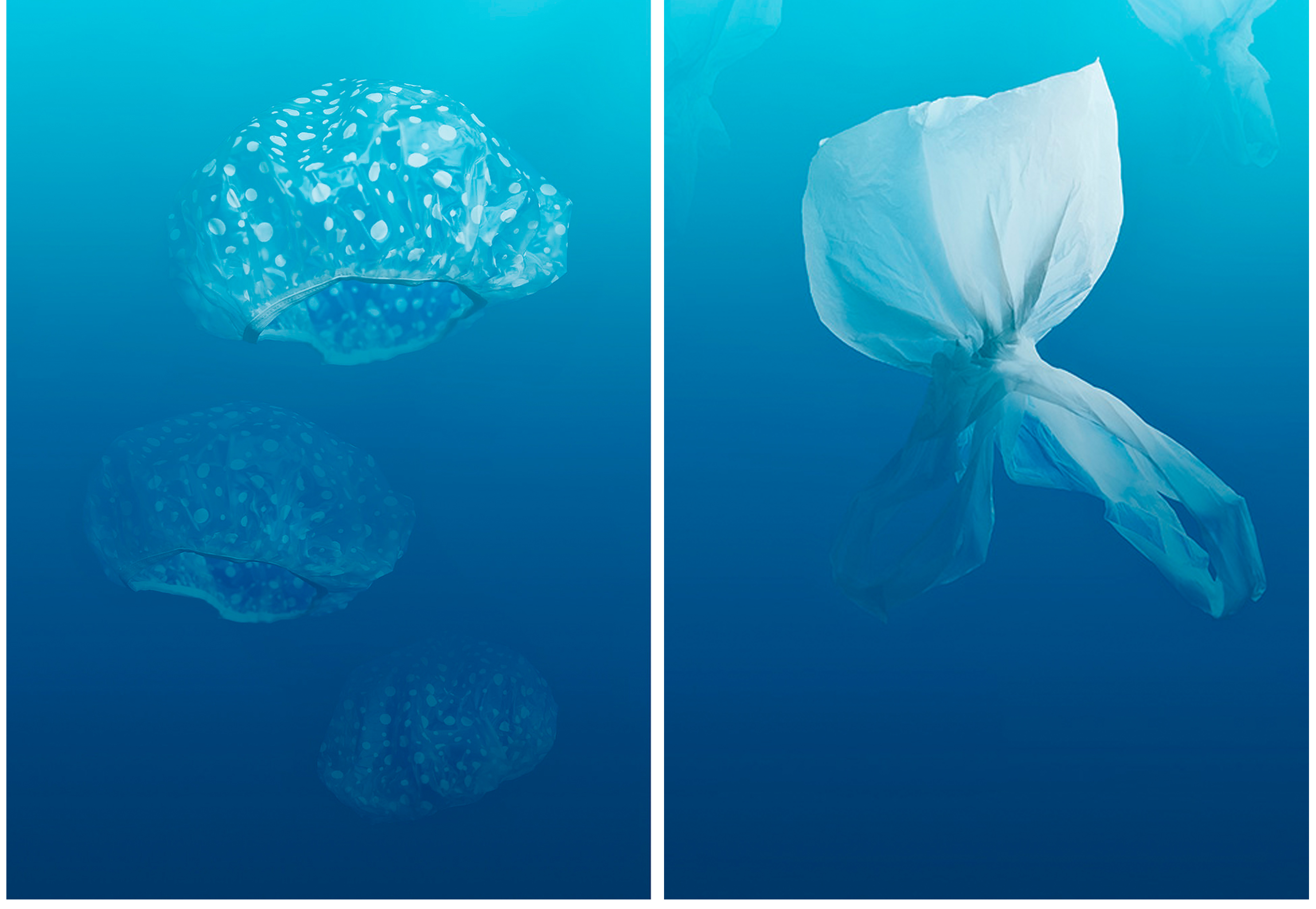 Much like with the work of Goussin and Hortense these images represent a bleak future for our oceans by creating seemingly living organic creatures from common household pollution. Again these pieces were influenced by humanities modern consumer culture, as well as being particularly inspired by the catastrophe of the ‘trash vortex’ in the North Pacific Ocean. The first image on the left shows basic shower caps floating together like a perfectly framed swarm of jellyfish in the vast blue ocean. I love the simplicity of the subject matter in this as, although it is obvious what they are, the shower caps are brought to life by their perspective, depth, and shape. The next image is of a plastic bag tied at the bottom to create the shape of a fish. I love the perspective of ‘the fish’ swimming away and the gradient of dark to light blue in the background, much like you would see in the ocean. I believe these types of photographs will be great pieces of historical evidence in the future, either to state our acknowledgement of the changing world or how we managed to save it before it’s too late.
Much like with the work of Goussin and Hortense these images represent a bleak future for our oceans by creating seemingly living organic creatures from common household pollution. Again these pieces were influenced by humanities modern consumer culture, as well as being particularly inspired by the catastrophe of the ‘trash vortex’ in the North Pacific Ocean. The first image on the left shows basic shower caps floating together like a perfectly framed swarm of jellyfish in the vast blue ocean. I love the simplicity of the subject matter in this as, although it is obvious what they are, the shower caps are brought to life by their perspective, depth, and shape. The next image is of a plastic bag tied at the bottom to create the shape of a fish. I love the perspective of ‘the fish’ swimming away and the gradient of dark to light blue in the background, much like you would see in the ocean. I believe these types of photographs will be great pieces of historical evidence in the future, either to state our acknowledgement of the changing world or how we managed to save it before it’s too late.
 To chose between these photographs, and produce a final collection, I was looking for a few certain aspects. To cut my shoot of around 50 images from each beach to these 7 originals above I was mainly concentrating on the quality of light and the perspective of my subject matter. My final results below show the photographs that most highlighted the subject matter, making it appear bigger against the location, and in result making my message more obvious. When editing these photographs the first things I did was crop them to make the pollution the first thing you notice. After that, I decided to keep all my results in colour because of the high contrast between the man-made objects against the colours of the natural locations…
To chose between these photographs, and produce a final collection, I was looking for a few certain aspects. To cut my shoot of around 50 images from each beach to these 7 originals above I was mainly concentrating on the quality of light and the perspective of my subject matter. My final results below show the photographs that most highlighted the subject matter, making it appear bigger against the location, and in result making my message more obvious. When editing these photographs the first things I did was crop them to make the pollution the first thing you notice. After that, I decided to keep all my results in colour because of the high contrast between the man-made objects against the colours of the natural locations… The first two finals above are depictions of the result of my beach clean ups on two separate beaches. The image on the left depicts a mixture public waste and fishing pollution with rocks and the sea in the background at a small quiet beach near Faldoeut. To create this image, as with the other outcomes as well, I simply walked to the length of my chosen beach and clustered together everything I could find. The meaning behind this image is mostly based on the huge green fishing net trapping everything it comes in contact with. This is a perfect example of the problem of fishing waste on marine life and the amount of it that is found in the sea. I like the dark overtones of this image along with the interesting composition and arrangement of items. The next photograph on the right is my least favourite outcome from this shoot, however, I still chose to include it in my blog as it clearly shows what was found on a well-known and recognisable beach, Gorey. I will not be featuring it in my final outcomes for this project as the subject matter of what I found is not very interesting.
The first two finals above are depictions of the result of my beach clean ups on two separate beaches. The image on the left depicts a mixture public waste and fishing pollution with rocks and the sea in the background at a small quiet beach near Faldoeut. To create this image, as with the other outcomes as well, I simply walked to the length of my chosen beach and clustered together everything I could find. The meaning behind this image is mostly based on the huge green fishing net trapping everything it comes in contact with. This is a perfect example of the problem of fishing waste on marine life and the amount of it that is found in the sea. I like the dark overtones of this image along with the interesting composition and arrangement of items. The next photograph on the right is my least favourite outcome from this shoot, however, I still chose to include it in my blog as it clearly shows what was found on a well-known and recognisable beach, Gorey. I will not be featuring it in my final outcomes for this project as the subject matter of what I found is not very interesting. These next two photographs are more abstracted examples of the pollution found on two separate beaches. The first image on the left was inspired by the amazing layering techniques used by Idris Khan and Stephanie Jung. Although their work usually revolves around much bigger landscapes I like the effect this technique has on my close up shot, and it abstracts the image and hopefully intrigues the viewer. By doing this, I hope this photograph may help spread awareness in a more light-hearted and artistic way. The next image on the right shows a straightforward closeup of the many strands of discarded rope found at Bouley Bay. I chose this photograph as a second final, as although it is similar to the one on the right, it can emphasise the problem of fishing waste in much more un-manipulated and realistic way. I like the dark contrasts between the many colours of the rope and the shadows in between as it really makes the subject matter stand out and look very dramatic.
These next two photographs are more abstracted examples of the pollution found on two separate beaches. The first image on the left was inspired by the amazing layering techniques used by Idris Khan and Stephanie Jung. Although their work usually revolves around much bigger landscapes I like the effect this technique has on my close up shot, and it abstracts the image and hopefully intrigues the viewer. By doing this, I hope this photograph may help spread awareness in a more light-hearted and artistic way. The next image on the right shows a straightforward closeup of the many strands of discarded rope found at Bouley Bay. I chose this photograph as a second final, as although it is similar to the one on the right, it can emphasise the problem of fishing waste in much more un-manipulated and realistic way. I like the dark contrasts between the many colours of the rope and the shadows in between as it really makes the subject matter stand out and look very dramatic. These last two photographs are from, what I consider to be, my most successful beach clean, completed at Bouley Bay. When putting together everything that I found I decided to loosely arrange it in categories of waste. By giving this rubbish pile some structure it allows the viewer to really easy to see and pick out nearly every single object that was there. The first image on the left is the classic scene of Bouley Bay with the interesting rock formation and tree behind my subject matter. I like the meaning behind this image as it is very clear to see, from this low angle perspective, the massive amount of waste on such a tiny little beach. I also love the composition of this subject matter, making it seem larger and emphasising its dramatic effect. The last photograph one the right is the same arrangement but taken from the other side. I like the context the Pier in the background gives this image, as it can tell us why this beach is often used and why it may have so much pollution. Overall I think these are the best images from this shoot because of the location, arranged subject matter and quality of light.
These last two photographs are from, what I consider to be, my most successful beach clean, completed at Bouley Bay. When putting together everything that I found I decided to loosely arrange it in categories of waste. By giving this rubbish pile some structure it allows the viewer to really easy to see and pick out nearly every single object that was there. The first image on the left is the classic scene of Bouley Bay with the interesting rock formation and tree behind my subject matter. I like the meaning behind this image as it is very clear to see, from this low angle perspective, the massive amount of waste on such a tiny little beach. I also love the composition of this subject matter, making it seem larger and emphasising its dramatic effect. The last photograph one the right is the same arrangement but taken from the other side. I like the context the Pier in the background gives this image, as it can tell us why this beach is often used and why it may have so much pollution. Overall I think these are the best images from this shoot because of the location, arranged subject matter and quality of light.